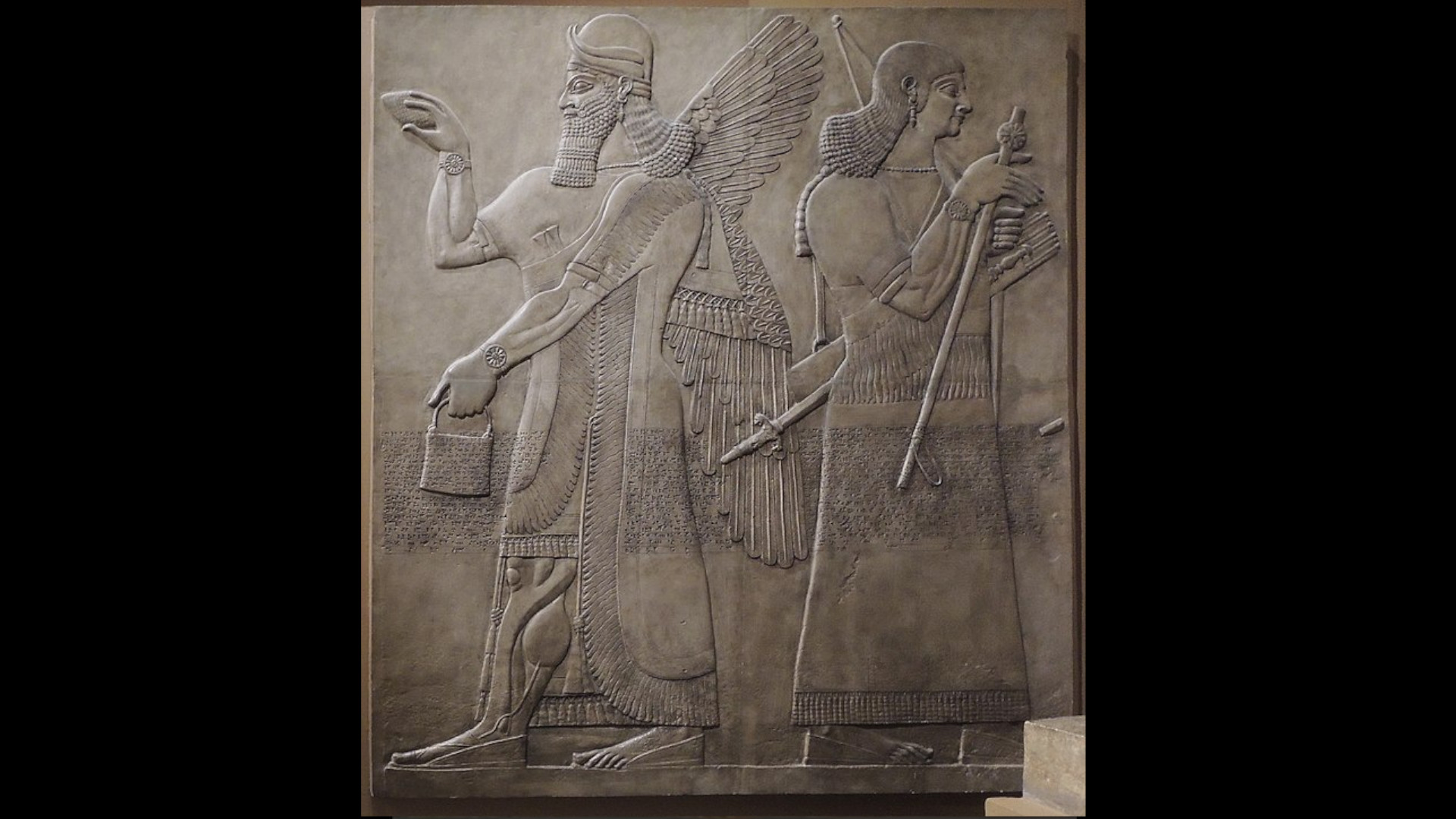Throughout history, the enigmatic depiction of handbags alongside or held by gods and mythological beings in ancient temples and sacred sites has intrigued historians and enthusiasts alike. These symbols, often intricately carved or depicted in bas-reliefs, suggest a deeper, perhaps esoteric significance lost to time. The ubiquitous presence of these handbag-like objects, found from Mesopotamian ruins to Mesoamerican artefacts, has sparked myriad theories ranging from practical explanations to profound spiritual interpretations. Whether they represent a physical tool of divine power, a container of sacred knowledge, or a metaphysical symbol of the cosmos, these ancient handbags remain a compelling mystery in the tapestry of human mythology and religious art.
The accompanying cone
In Mesopotamian art, particularly in the reliefs and carvings of ancient Assyria, beings, often divine or semi-divine figures, are frequently depicted carrying a cone alongside the enigmatic handbag. This cone, identified as the “cone of life” or “cone of fertilisation,” is believed to symbolise fertility, regeneration, and the transmission of divine blessings. These figures, such as the Apkallu (sage beings), are shown performing ritualistic acts, often using the cone to sprinkle or anoint sacred spaces, indicating its role in purification and consecration rites. The combination of the cone and handbag underscores the Mesopotamians’ emphasis on the duality of spiritual nourishment and divine protection, encapsulating their sophisticated religious and cosmological understanding.
Interpretations
Many scientists and historians interpret the ubiquitous handbags in ancient depictions as mundane objects integral to daily life, perhaps representing pouches for carrying tools, seeds, or other essential items. This practical viewpoint aligns with the idea that these artifacts were simply everyday items utilized by ancient peoples in their routines and ceremonies. However, some researchers and enthusiasts delve deeper, proposing that these handbags may hold symbolic meanings or esoteric knowledge. These theories range from the bags being containers of sacred wisdom or cosmic power to representing metaphysical concepts or advanced technology possessed by ancient civilisations. This divergence in interpretations highlights the rich lacery of human history, where tangible artifacts often intertwine with layers of cultural and spiritual significance.
Male and female
One intriguing interpretation of the ancient Mesopotamian depictions of the cone and the handbag suggests that these objects symbolise the fundamental concept of polarity, representing male and female principles. In this view, the cone, with its phallic shape, embodies masculine energy, associated with fertility, action, and the initiation of life. Conversely, the handbag, seen as a vessel or container, symbolises feminine energy, embodying receptivity, nurturing, and the capacity to hold and sustain life. Together, these symbols encapsulate the dual forces of creation and balance, mirroring the harmony between active and passive elements in the cosmos. This interpretation highlights the profound understanding of duality and the interplay of opposing forces in ancient spiritual and cosmological beliefs.
A battery pack
Some researchers have speculated that the ancient handbags depicted alongside gods and mythological beings might be akin to batteries, serving as sources of power for those who possess the knowledge to utilise them. This theory posits that these bags were not merely symbolic or practical objects but rather advanced technological devices capable of storing and transmitting energy. Drawing parallels to the Baghdad Battery, a collection of ancient artefacts believed by some to be an early form of electrochemical cell, proponents of this idea suggest that the handbags could have been used to harness and control energy for various purposes, such as healing, communication, or even weaponry. This interpretation challenges conventional historical perspectives, inviting a reexamination of the technological capabilities and scientific knowledge of ancient civilisations.
Communication devices
An even more radical theory suggests that the ancient handbags depicted in various mythological and religious contexts were actually communication devices, potentially used by gods or advanced beings to connect across vast distances or dimensions. Proponents of this idea argue that these objects, often depicted with deities and divine figures, signify a form of advanced technology that enabled supernatural communication or interaction. This theory draws on the notion that ancient civilisations might have had access to sophisticated knowledge or extraterrestrial contact, allowing them to create tools for transcendent communication. Such interpretations push the boundaries of conventional archaeology, proposing that these handbags were not just symbolic or practical objects, but instruments of interdimensional or interstellar communication, reflecting a forgotten era of advanced technological prowess.
Purification
Another compelling interpretation of the handbag and cone in ancient Mesopotamian depictions is that they represent a bucket and a purification device. In this view, the cone was likely dipped into the bucket, which contained sacred water or anointing oil, and then used to sprinkle or daub the substance onto a person or place to cleanse and purify them. This ritualistic act of consecration would have been essential in religious ceremonies, symbolising the imparting of divine blessings and protection. This interpretation underscores the practical and spiritual roles these objects played, reflecting the ancient belief in the necessity of purification and sanctification in maintaining harmony and favour with the divine.
In summary
The ancient handbags depicted across various cultures and civilisations in reliefs and works of art remain one of history’s most intriguing enigmas. From the temples of Mesopotamia to the monuments of Mesoamerica, such symbols appear consistently, suggesting a shared or universally resonant significance. Interpretations range widely, some see them as mundane objects integral to daily life, while others propose symbolic, esoteric, or even technological meanings. Whether viewed as containers of sacred wisdom, symbols of duality, purification tools, or advanced devices for energy or communication, these handbags encapsulate the rich, and sometimes puzzling mysteries that exist for humanity to explore throughout our remarkable history.
